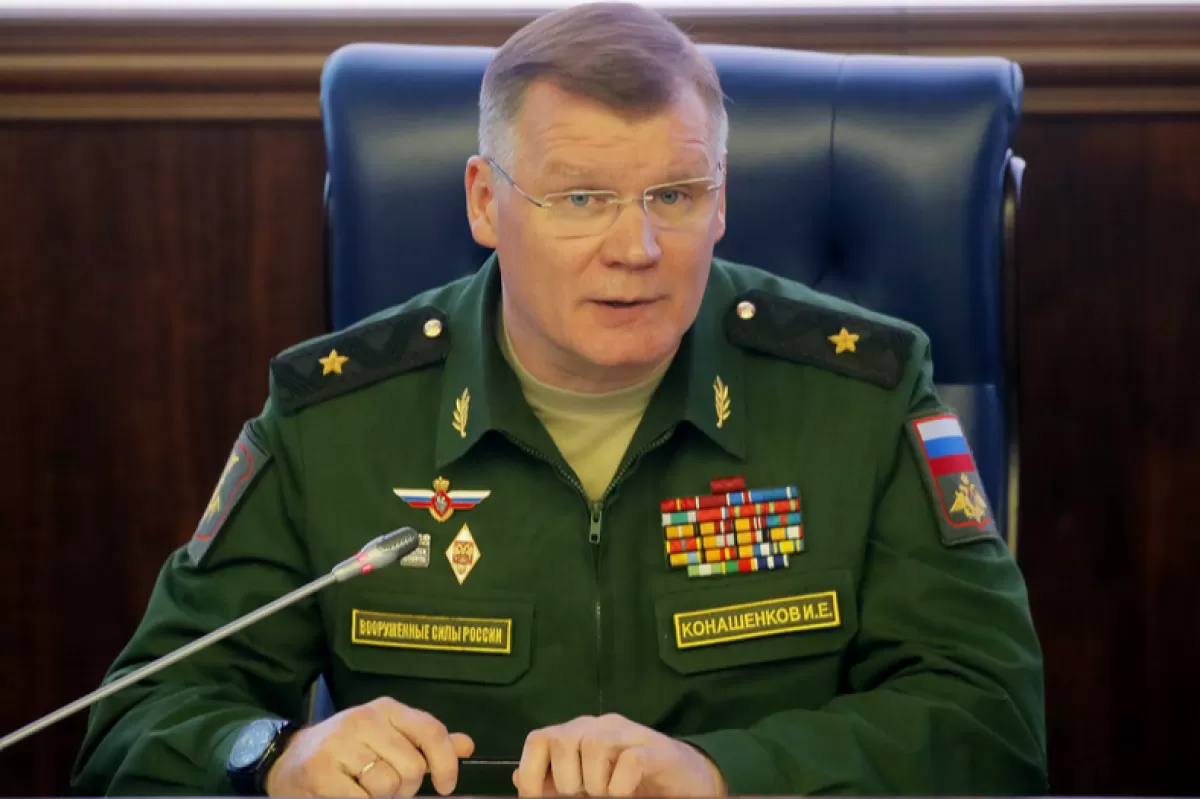
Every day, Russian citizens learn from news segments about the victories reported by the Russian army on the Ukrainian front. Even when troops are retreating or conquering a few small villages despite sustaining heavy losses, the Ministry of Defense spokesman, Igor Konashenkov, invokes resounding achievements. A PROEKT.MEDIA investigation reveals that many such achievements are in fact mathematical and geographical falsehoods.
Vladimir Putin announced the start of the “special military operation” in Ukraine in the early hours of February 24. Later that day, the Defense Ministry spokesman, Igor Konashenkov, already reported that “as a result of the recent attacks of the Russian forces, 74 Ukrainian military infrastructure objectives have been destroyed”.
This figure might sound impressive, were we not to pay attention to the math further suggested by the representative of the military department. The list of objectives includes 11 airports, four Bayraktar drones, 18 radar stations, three command centers, a naval base and one gunship – in total half the figure Konashenkov had announced.
Let’s do the math: 11+4+18+3+1=37
Therefore, from its very onset, the war launched an era of repeated falsehoods about Russia’s military achievements. Whereas the first example of inconsistency can be explained by Konashenkov’s choice of concealing certain details, his following blunders can no longer be justified. Proekt has monitored all of Koneshenkov’s press briefings since the start of the war, and concluded that the data presented by the Russian Ministry of Defense contain a lot of errors, they defy basic rules of mathematics and geography and lack common sense. For the sake of preserving the illusion of success, Shoigu’s subordinates have even devised a language of their own. Without knowledge of this different Russian language, it is impossible to decode the declarations of military officials.
Konashenkov’s dictionary
“Overall, resistance is provided mainly by armed groups of nationalists. Ukrainian servicemen are trying to evade combat”, it’s how Konashenkov started manipulating the Russian language from the first day of the war.
The press secretary of the Ministry of Defense distinguished between those who had allegedly retreated or surrendered, whom he respectfully calls Ukrainian servicemen, and those who mount a resistance, whom he calls “nationalists”. In fact, the myth about Russia’s swift victory and the refusal of the Ukrainian army to fight back stopped being relevant after just a week. In early March, it became clear that Russia’s blitzkrieg in Ukraine had failed, which prompted Konashenkov to swiftly change his rhetoric, abandoning the divide between bad nationalists and good servicemen. Now, terms such as “nationalists” and “Nazis” became the generic definition of the enemy. “Ukraine’s armed forces” are only referenced in the context of military infrastructure.
[…]
To make the war ideologically appealing and successful in the eyes of the Russian public back home, the Ministry of Defense is employing a plethora of ambiguous terms. On February 25, Konashenkov solemnly proclaimed: “The blockade of Chernihiv has been successfully completed”. The phrase appears to signal a success, but in fact fighting was still unfolding at the time on the city outskirts. In the end, the city was never captured. Moreover, the very term “captured” was never used by the Ministry of Defense. Rather, the Russian army “takes control” of cities and villages in Ukraine. […]
Understandably, Konashenkov seldom mentions civilian casualties and constantly blames Ukrainians for their deaths. […]
Naturally, Konashenkov never referred to the retreats of the Russian army. The pullout from Kyiv and Chernihiv at the end of the March was called “a planned regrouping of troops”.
Nationalists, militants, Nazis – Ukrainian servicemen
Take control – capture a city, village or town in Ukraine
Block – the Russian army is fighting on the outskirts of the city, but cannot capture it
Cleansing – fighting on the streets
Planned regrouping of troops – the retreat of the Russian army
Special military operation – war
It appears there have been a lot of “planned regroupings”, meaning retreats, to the extent that Konashenkov had to improvise not just with terminology, but also with geography.
“Control has been established over Krasny Liman, Torskoye, Kremmenaya”, he reported on March 2, referring to the victory of the Russian army in Luhansk.
On the first days of the war, Konashenkov created the illusion of success by enumerating a number of smaller towns and villages the Russian army “had taken control of” – an average of eight settlements per day. As if real victories were not enough, old victories were now repeated. At any rate, viewers are unable to recognize unknown names and therefore are inclined to take reports of new victories at face value. The Ministry of Defense spokesman particularly highlighted the town of Kremmenaya, located 95 km northwest of Luhansk.
On March 7, only five days after the first town was captured, Konashenkov reported the Russian army had taken control of the towns of Smolyaninovo, Voevodsk and Kremennaya. On March 8, LNR troops advanced nine kilometers and again took control of “Borsonino and Kremennaya”, for the third time. In all likelihood, the city was not actually captured in March […].
Furthermore, on March 31, Konashenkov again referred to the city that had been “taken” three weeks ago, announcing LNR troops had been fighting Ukrainian nationalists on the outskirts of Kremennaya. According to Konashenkov, the northern outskirts were blocked on April 1, whereas on April 21, over a month and a half since his first briefing, he mentioned for the fourth time the city had been captured “without inflicting significant damage to urban infrastructure and residential buildings.” The same is true of Krasny Liman: the city was conquered for the first time on March 2. Over the coming months, however, weapons caches or “Ukrainian forces in firing position” magically appeared on the territory that was supposed to be controlled by the Russian army. The forces were immediately annihilated. Nearly three months later, on May 28, Konashenkov again announced the capture of Krasny Liman.
These are no exceptions to the rule, but the rule itself. Examining Konashenkov’s press briefings, Proekt has identified at least 25 towns and villages that were captured several times.
[…]
The public has been fed miscalculations from the first days of the “special operation” – conflicting statements made within the space of a single day. On February 28, the Defense Ministry press secretary reported in the morning that 314 tanks had been destroyed since the start of the operation, and later that evening – 311. The same happened with other types of equipment. […]
A genuine flood of briefings regarding Ukraine’s losses started on April 13, although two weeks earlier (March 30), the Ministry announced “a planned regrouping of troops”, meaning Russian forces were retreating from the Kyiv area. Since then there have been no major developments on the front. Konashenkov, however, reported the destruction of not dozens, but hundreds of Ukrainian military infrastructure objectives.
[…]
Fighting ghosts
“Kyiv’s air forces have been almost entirely destroyed”, Konashenkov announced on March 6, namely a week and a half since the war had started.
According to his statement at the time, Russia had destroyed 93 aircraft, either in flight or on the ground. Indeed, this would account for most of Ukraine’s air forces. Prior to the war, Ukraine had 98 military aircraft, 35 carriers and 5 special aircraft – taking the total to 138 units. In theory, the Russians might have been able to destroy trainer aircraft as well: the Ukrainian army owned 61 such aircraft. Even if we take these into account, the total would still be shy of 200. On the other hand, the Ministry of Defense itself had stated that, before the war, Ukraine’s air forces consisted of 152 aircraft.
Whichever of these figures is correct, at any rate Konashenkov had exceeded the sum total, claiming 215 aircrafts had been destroyed by June 26.
Russian propaganda claims Ukrainian losses are growing because the Russian army is destroying military aid delivered to Ukraine by Europe and the USA. According to open sources, Western countries might have provided Ukraine with military aircraft, although no country officially reported that. At the end of May, the Ukrainian media merely wrote that Ukraine had received disassembled Su-25 fighter jets.
[…]
On June 26, Konashenkov announced the destruction of over 3,800 armored vehicles and tanks. Yet it was the Ministry of Defense itself that estimated Ukraine had merely 2,416 armored units. Another 700 armored vehicles have been delivered by Ukraine’s allies. How Ukraine continues to fight after having lost all its equipment remains a mystery.
[…]


